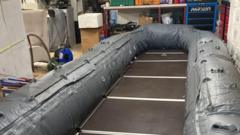
The scantily clad couple moves purposefully through the woods, always staying close to the creek. Their clothing, made from woven plant material and animal skins, keeps them warm enough in the sunlight of this autumn day. He strides ahead, she comes behind, carrying baskets and herding the children, several members of their extended family and his elderly parents, who struggle to keep up.
They are on a mission: gathering the berries and nuts that are ripe this time of year and hunting the small animals that come down to the stream to drink. But first they are looking for something, a place they know well. A place they return to every spring and fall to hunt and gather.
A place where they can find all the comforts of home – a roof over their heads, a warm fire, fresh water, and relative security. After many hours of walking and checking off remembered landmarks, the man looks up the steep, wooded hill, relieved to find the overhanging rock he knew would be there. He turns to his family in the woods of what would become Pennsylvania and gives his orders.
Some split off to gather wood, some fetch water using tightly woven baskets, and all look forward to spending several weeks in this camp with a secure roof over their heads. They climb the steep hill and take cover under the expansive rock shelter, which is large enough to walk upright in, spacious enough for the entire family, and has a ceiling so high that the smoke from their fires vent outside with little discomfort to the occupants. They light a fire using the technology of the day, and the pungent smells of small game and roasting plants fill the air.
They are safe in this place, which is easily defended from intruders. Tomorrow they will search the area for food. Tonight, they are happy to rest in a place that stays dry, even when it rains.
Nineteen thousand years have passed since groups like this one used the rock shelter as a temporary home. They had no idea that archaeologists, living in a world they could not begin to imagine, would find artifacts of their stay: charcoal from their fires, discarded stone arrowheads, bones left over from their meals of small game, and baskets they left behind for reasons only they knew. Meadowcroft Rockshelter and Historic Village is recognized throughout the world as the place that challenged conventional wisdom about when our ancestors populated North America.
For the intellectually curious, it’s one of the few places in the world where you can get a close-up view of ancient, prehistoric fire pits. For families, it’s a place to have fun, have new experiences and explore both our ancient and more recent heritage. For students, Meadowcroft shows them what their lives would have been like if they had been in school centuries ago.
Meadowcroft is nearby in Avella. Don’t wait another 19,000 years to check it out. Visit, https://www.
heinzhistorycenter.org/visit/meadowcroft/..














